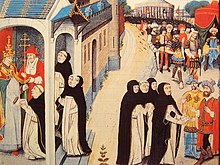Nicolaus Ascelinus
Nicolaus Ascelinus ( Italian Ascelino di Lombardia ; also Ascelin of Lombardy and Ascelin of Cremona ) was an Italian Dominican and Mongolian traveler. The friar from Lombardy led a travel expedition to what is now Azerbaijan between 1245 and 1248 .
Life
In March 1245, Ascelin was entrusted by Pope Innocent IV in Lyon with a diplomatic mission to the Mongolian general Baiju, who was operating in the Persian region . In addition, copies of the letters of March 5 and 13, 1245 (Dei patris inmensa; Cum non solum) intended for the missions of Lorenz of Portugal and Johannes de Plano Carpini , in which the Mongols to cease their atrocities and to Encourage acceptance of Christianity.
Ascelin did not begin his journey until 1246, accompanied by his friars Alexander and Albert. In the Holy Land to them the travel writer joined another Dominican, Simon of Saint-Quentin (Historia Tartarorum) . Brother Guichard von Cremona recently joined them in Tbilisi , Georgia , and he acted as interpreter for the rest of the journey. On May 24, 1247 the embassy reached the camp of the Baiju east of Lake Sevan in the Arrān region . He almost had the monks executed after Ascelin refused to bow to him. On July 17th, the general Iltschikadai arrived in the camp, who was to replace Baiju as commander-in-chief in Persia on the instructions of the new Great Khan Güyük . To this end, he had brought with him a reply from the ruler intended for the Pope, with the same content as the ambassador Carpini had received the year before. The Khan showed no interest in accepting the Christian faith and instead demanded the submission of the Pope and all the kings of Europe to his rule. On July 25, 1247, Ascelin and his companions started their journey home. From the Mongols, two Nestorians, Aibeg and Serkis, were sent as emissaries. It was not until the summer of 1248 that they returned to the papal court in Lyon.
According to Simons von Saint-Quentin's travel report, Baiju and the Mongols had left a very negative impression on Ascelin, which they regarded as highly dangerous and resistant to negotiations with the Christian world.
literature
- Luciano Petech: Ascelino (Azzelino; erroneamente anche Anselmo). In: Alberto M. Ghisalberti (Ed.): Dizionario Biografico degli Italiani (DBI). Volume 4: Arconati-Bacaredda. Istituto della Enciclopedia Italiana, Rome 1962.
- Gregory G. Guzman: Simon of Saint-Quentin and the Dominican Mission to the Mongol Baiju: A Reappraisal, in: Speculum, Vol. 46 (1971), pp. 232-249.
Individual evidence
- ↑ Variant of writing: “Ascelin of Lombardy” in: Steven Runciman: History of the Crusades. CH Beck, Munich 1995, p. 1036. ISBN 978-3-406-39960-2
- ↑ See Monumenta Germaniae Historica , Epp. saec. XIII 2, No. 102, p. 72f; No. 105, pp. 74f.
| personal data | |
|---|---|
| SURNAME | Ascelinus, Nicolaus |
| ALTERNATIVE NAMES | Ascelino di Lombardia; Ascelin from Lombardy; Ascelin from Cremona |
| BRIEF DESCRIPTION | Italian Dominican and Mongolian traveler |
| DATE OF BIRTH | 13th Century |
| DATE OF DEATH | 13th Century |
